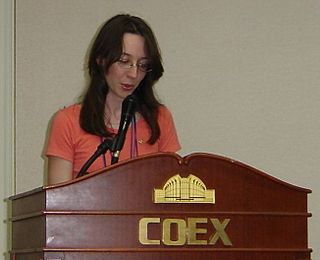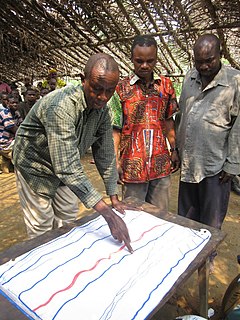
Vallejo is a city in Solano County, California and the second largest city in the North Bay region of the Bay Area. Located on the shores of San Pablo Bay, the city had a population of 126,090 at the 2020 census. Vallejo is home to the California Maritime Academy, Touro University California and Six Flags Discovery Kingdom.
Participatory democracy or participant democracy is a form of government in which citizens participate individually and directly in political decisions and policies that affect their lives, rather than through elected representatives. Elements of direct and representative democracy are combined in this model.

Citizen Participation or Public Participation in social science refers to different mechanisms for the public to express opinions—and ideally exert influence—regarding political, economic, management or other social decisions. Participatory decision-making can take place along any realm of human social activity, including economic, political, management, cultural or familial.
Governance is the process of interactions through the laws, norms, power or language of an organized society over a social system. It is done by the government of a state, by a market, or by a network. It is the decision-making among the actors involved in a collective problem that leads to the creation, reinforcement, or reproduction of social norms and institutions". In lay terms, it could be described as the political processes that exist in and between formal institutions.

Participatory budgeting (PB) is a type of citizen sourcing in which ordinary people decide how to allocate part of a municipal or public budget through a process of democratic deliberation and decision-making. Participatory budgeting allows citizens or residents of a locality to identify, discuss, and prioritize public spending projects, and gives them the power to make real decisions about how money is spent.

Citizen media is content produced by private citizens who are not professional journalists. Citizen journalism, participatory media and democratic media are related principles.

Joseph A. Moore is a former Chicago politician. Moore was first elected to Chicago City Council as the alderman for the 49th ward, which includes the majority of Rogers Park and portions of West Ridge, in 1991. Moore won re-election six times, before losing to challenger Maria Hadden in 2019.
Public participation, also known as citizen participation or patient and public involvement, is the inclusion of the public in the activities of any organization or project. Public participation is similar to but more inclusive than stakeholder engagement.

The government of the City and County of San Francisco utilizes the "strong mayor" form of mayoral/council government, composed of the Mayor, Board of Supervisors, several elected officers, and numerous other entities. It is the only consolidated city-county in California, and one of only thirteen charter counties of California. The fiscal year 2019–20 city and county budget was approximately $12.3 billion.

Participatory planning is an urban planning paradigm that emphasizes involving the entire community in the community planning process. Participatory planning emerged in response to the centralized and rationalistic approaches that defined early urban planning work. It has become a highly influential paradigm both in the context of traditional urban planning, and in the context of international community development. There is no singular theoretical framework or set of practical methods that make up participatory planning. Rather, it is a broad paradigm which incorporates a wide range of diverse theories and approaches to community planning. In general, participatory planning programs prioritize the integration of technical expertise with the preferences and knowledge of community members in the planning process. They also generally emphasize consensus building and collective community decision making, and prioritize the participation of traditionally marginalized groups in the planning process.
Chapter 9, Title 11, United States Code is a chapter of the United States Bankruptcy Code, available exclusively to municipalities and assisting them in the restructuring of their debt. On July 18, 2013, Detroit, Michigan became the largest city in the history of the United States to file for Chapter 9 bankruptcy protection. Jefferson County, Alabama, in 2011, and Orange County, California, in 1994, are also notable examples. The term 'municipality' denotes "a political subdivision or public agency or instrumentality of a State," but does not include a state itself. States are therefore unable to file for bankruptcy, even though they have defaulted in their obligations.
Janaagraha Centre for Citizenship and Democracy (www.janaagraha.org) is a non-profit trust, working towards the mission of transforming the quality of life in India’s cities and towns. Founded in 2001 by Ramesh Ramanathan and Swati Ramanathan, it started as a movement to include people’s participation in public governance and has now evolved into a robust institution for citizenship and democracy. The core idea of Janaagraha’s work does not revolve around fixing problems but instead seeking to fix the system that can solve the problems. To achieve this objective, Janaagraha works with citizens to catalyse active citizenship in city neighbourhoods and with governments to institute reforms to city governance.
A tax-free savings account is an account available in Canada that provides tax benefits for saving. Investment income, including capital gains and dividends, earned in a TFSA is not taxed in most cases, even when withdrawn. Contributions to a TFSA are not deductible for income tax purposes, unlike contributions to a registered retirement savings plan (RRSP).

Proposition 11 of 2008 was a law enacted by California voters that placed the power to draw electoral boundaries for State Assembly and State Senate districts in a Citizens Redistricting Commission, as opposed to the State Legislature. To do this the Act amended both the Constitution of California and the Government Code. The law was proposed by means of the initiative process and was put to voters as part of the November 4, 2008 state elections. In 2010, voters passed Proposition 20 which extended the Citizen Redistricting Commission's power to draw electoral boundaries to include U.S. House seats as well.

SolTrans, officially Solano County Transit, is a Joint Powers Authority that provides public transportation service to the southern Solano County cities of Vallejo and Benicia. SolTrans was established in 2011 and is the result of a merger between Vallejo Transit and Benicia Breeze. In 2021, the system had a ridership of 477,400, or about 1,800 per weekday as of the fourth quarter of 2021.
As of 2015, over 1,500 instances of participatory budgeting (PB) have been implemented across the five continents. While the democratic spirit of PB remains the same throughout the world, institutional variations abound.

California Proposition 15 was a failed citizen-initiated proposition on the November 3, 2020, ballot. It would have provided $6.5 billion to $11.5 billion in new funding for public schools, community colleges, and local government services by creating a "split roll" system that increased taxes on large commercial properties by assessing them at market value, without changing property taxes for small business owners or residential properties for homeowners or renters. The measure failed by a small margin of about four percentage points.
Valérie Issarny is a Director of Research at the National Institute for Research in Digital Science and Technology (INRIA), France. Issarny is known for her research in middleware solutions for distributed collaborative services, including mobile services deployed over smartphones that interact with sensors.
Oral democracy is a talk-based form of government and political system in which citizens of a determined community have the opportunity to deliberate, through direct oral engagement and mass participation, in the civic and political matters of their community. Additionally, oral democracy represents a form of direct democracy, which has the purpose of empowering citizens by creating open spaces that promote an organized process of discussion, debate, and dialogue that aims to reach consensus and to impact policy decision-making. Political institutions based on this idea of direct democracy seek to decrease the possibilities of state capture from elites by holding them accountable, to encourage civic participation and collective action, and to improve the efficiency and adaptability of development interventions and public policy implementation.
Tiago Carneiro Peixoto is a Brazilian political scientist and Senior Governance Specialist at the World Bank, who promotes participatory democracy around the globe. Recognized as an expert in e-democracy and participatory democracy, he was nominated as one of the most innovative people in democracy, as well as one of the 100 most influential people in digital government.








